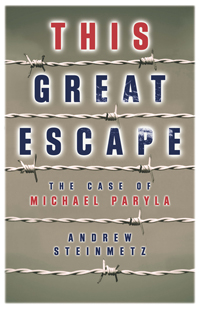Reviews
Nonfiction Review by Jay Ruzesky
Andrew Steinmetz, This Great Escape: The Case of Michael Paryla (Windsor: Biblioasis, 2013). Paperbound, 282 pp., $19.95. 
To celebrate the premiere of The Great Escape in London in June 1963, a band from the Royal Air Force played outside the Strand Theatre and planes flew in formation overhead. The film did not win a lot of awards, but it was a popular movie and it did well at the box office. Fifty years later, The Great Escape is memorable for its iconic images: Steve McQueen jumping his 650 Triumph over a fence, McQueen bouncing a baseball against the wall of “the cooler,” Charles Bronson snaking his way through tunnels, James Garner looking guilty. The ensemble cast of good actors fuelled the tension in the plot based on an incident from WWII. One of the less memorable actors is Michael Paryla who is uncredited and appears in the film for less than a minute of screen time as a German officer inspecting the papers of passengers on a train as he searches for dozens of escaped prisoners. Though not much of a player in the film, he becomes—fifty years later—the central focus of Andrew Steinmetz’s memoir, This Great Escape. Once or twice removed “cousin” Michael is one of the family’s claims to fame—a dashing young actor who had a part in a popular movie and died young from a mix of alcohol and barbiturates. He is someone Steinmetz was aware of as a child through family lore around the kitchen table. Growing up before the age of instant online everything, Steinmetz did not see the film until he was in his teens.
Obsession is an element of good nonfiction and Steinmetz is clearly obsessed with finding out anything he can about Michael Paryla. He talks to everyone he can think of: family, friends, strangers on the street in Germany, and he writes, emails, and tweets those he can’t visit including a Canadian professor who was an extra in the film but, not surprisingly, has never heard of Michael Paryla and is not much help. There is an air of mystery to the book, which helps fuel the plot—no one knows for sure if Paryla’s death was an accident, and in addition to simply wanting to know all there is to know about his “cousin,” Steinmetz sets himself up as a detective working a murder case. Yet, he can’t really know. There is no new evidence to be unearthed; all he can do is hope that Paryla’s death was not its own kind of escape from a challenging life.
Steinmetz is a thoughtful writer and there are some moving, witty, and even profound moments in the book. For me, the obsession wanes as the book goes on. I want to be as interested in the little-known actor as the writer is, but the fascination doesn’t quite translate. On first seeing the film as a teenager, Steinmetz admits that he was “too immature to appreciate that Being Not McQueen made Michael someone just as interesting to follow on screen, and off. [Steinmetz] had yet to learn that just possibly every ordinary human life is heroic, and the fact that most ordinary lives are forgotten makes them that much more heroic.” It’s a lovely sentiment and I agree without reservation. The irony is that because the book is so obsessed with Michael Paryla, many of the people Steinmetz meets on his quest are not given the chance to become full characters. I wanted Steinmetz to allow some of them to become as memorable as they might be, but because he’s so focused on Michael’s story, he forgets they have one too.
The other aspect of the book that is problematical is its lack of structure. On one hand, I admire This Great Escape for its risky shape. I was pleased to find a departure from linear form in a book that is, necessarily I think, made up of fragments of thought, oral history, memoir, and research. At times, though, the form of the text seemed to have little purpose. There is a long section in the middle of the book called “The Great Escape...For Those Who Missed It” in which some history, background, and insight into the film are provided and, interesting as some of the information is, the thirty-six page chapter seems a long diversion from the story. I am fond of books that challenge structural conventions, like Michael Ondaatje’s Running in the Family or the lyrical essays of Diane Ackerman or Annie Dillard. As a poet, Steinmetz’s often charged language lets him get away with a number of intellectual leaps and arabesques, but I wanted the dance to be more coherent.
—Jay Ruzesky









